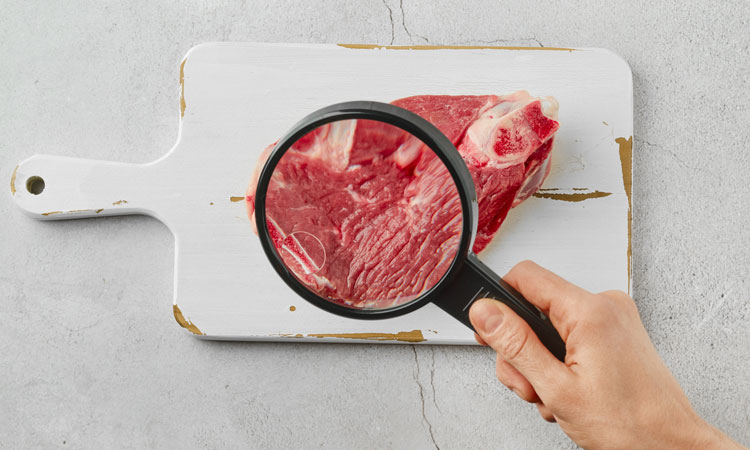Cultivated meat: how close is it to US plates?
- Like
- Digg
- Del
- Tumblr
- VKontakte
- Buffer
- Love This
- Odnoklassniki
- Meneame
- Blogger
- Amazon
- Yahoo Mail
- Gmail
- AOL
- Newsvine
- HackerNews
- Evernote
- MySpace
- Mail.ru
- Viadeo
- Line
- Comments
- Yummly
- SMS
- Viber
- Telegram
- Subscribe
- Skype
- Facebook Messenger
- Kakao
- LiveJournal
- Yammer
- Edgar
- Fintel
- Mix
- Instapaper
- Copy Link
Posted: 15 March 2023 | Bryant Godfrey, Michelle Choi, Tina Papagiannopoulos | No comments yet
Bryant Godfrey from law firm Foley Hoag reflects on the progress of cultivated meat production and what challenges remain on the US regulatory landscape.


One day, you might be able to bite into a hamburger from an animal that has never grazed in a pasture or munched on a salmon roll from a fish that has never swum in any waters. Yet despite the rapid progression of the technology, regulators and policymakers still have work to do to ensure that cultivated meat is safe so that consumers can have confidence in these products.
What is cultivated meat?
Cultivated, cultured or lab-grown meat is grown in a lab from animal cells. The first step involves extracting and banking the stem cells from an animal. The cells are then fed with nutrients, proteins and other growth mediums in bioreactors, to stimulate growth. When the cells reach the desired density, they are differentiated into various meat parts, such as skeletal muscle and fat, through changes in the medium composition. Finally, the cultivated meat is harvested through a centrifugation process, prepared and packaged for distribution. This cell-cultivation process can be used to produce a variety of animal meats, including seafood, poultry and organ meats.1
Cultivated meat could eliminate major sources of emissions from animals and create less food waste; plus, the technology side-steps the ethical concern of killing a live animal for consumption
This technology holds the potential to address many of today’s environmental, ethical and public health concerns, especially related to the traditional method of rearing animals for meat. Consumer acceptance of cultivated meat could potentially reduce greenhouse gas emissions caused by food production as the technology involved is associated with lower land, water and nutrient footprints.2 Furthermore, it could eliminate major sources of emissions, from animals, and create less food waste;2 plus, the technology side-steps the ethical concern of killing a live animal for consumption.
As another potential benefit, the nutritional profile of the meat could potentially be adjusted to include healthier fats and vitamins and less saturated fat and cholesterol. Perhaps most notably, reduced reliance on traditional meat products could decrease antibiotic resistance issues in humans. Antibiotics have been commonly used in live animal rearing to reduce infection in livestock, but its overuse is emerging as a big threat to public health.3
As the technology is still new, regulation of cultivated meat has also yet to reach its maturity. The US currently does not allow food made from cultured animal cells to be sold for consumption. So far, Singapore is the only country that allows the commercial sale of cultivated meat. However, many other countries, including Japan, China and Israel, are exploring various options to introduce cultivated meat to their respective country’s market.
Authority of FDA and USDA over food products
Both the US Food and Drug Administration (FDA) and the Food Safety and Inspection Service (FSIS) agency of the United States Department of Agriculture (USDA) have the statutory authority to regulate certain aspects of cell-cultivated meat. In general, FDA’s regulatory authority over food extends to all foods and food ingredients in interstate commerce, except for non-game meat, poultry, processed egg products and Siluriformes (catfish).4 Certain aspects of the safety and labelling of these types of food are regulated by the USDA, whereas FDA directly regulates the production of game meat, whole eggs in their shell, and non-meat products, such as dairy, produce, nuts, spices, cereals, legumes and other fish and shellfish products, as well as packaged foods.5


Cultivated meat could eliminate major sources of emissions from animals and create less food waste; plus, the technology side-steps the ethical concern of killing a live animal for consumption
Cultivated meat could eliminate major sources of emissions from animals and create less food waste; plus, the technology side-steps the ethical concern of killing a live animal for consumption
Generally, to call a product “meat” or “poultry,” the label must follow the requirements under the Federal Meat Inspection Act of 1906 (FMIA)6 and the Poultry Products Inspection Act of 1957 (PPIA)7 and must not be false or misleading.8 The label is also considered “misbranded” if a company attempts to sell an imitation of meat or poultry, without labelling it as such.8 Although the specific labelling for cultivated meat is still being developed, USDA has raised the possibility that the terms “meat” and “poultry,” especially as standalone terms, may not be available for cultivated food products.10
As the category of cultivated meat did not neatly fall under FDA or USDA jurisdiction, the two agencies entered into a formal agreement in 2019 to jointly oversee the production of cultivated cells.11 Pursuant to this agreement, the two agencies outlined how they would co-ordinate with each other to regulate cultivated meat to ensure that products that incorporate cultivated meat are safe and accurately labelled.
Roles of FDA and USDA-FSIS
Under the formal agreement, FDA’s role includes:12
- Overseeing the collection of animal cells, cell banks, and cell growth and differentiation
- Conducting a voluntary pre-market consultation process that evaluates the safety of cultivated meat before it enters the market
- Inspecting records and facilities.
After this, the regulatory baton passes onto USDA-FSIS, whose role under the formal agreement includes:13
- Overseeing the harvesting of the cell culture process. The harvesting stage is when cells are removed from a sealed growth environment and prepared for food processing.
- Overseeing the further production of the cultivated meat
- Ensuring that all cultivated meat is labelled truthfully and consistently with co-ordinated FDA and USDA-FSIS principles for product labelling and claims. USDA-FSIS must preapprove all cultivated meat and poultry labelling. FSIS intends to eventually publish new labelling regulations for cultivated meat and poultry products.
Outside the formal agreement, FDA will also, through its regulatory authority under the FDCA and Public Health Service Act (PHSA):
- regulate the processing of both the food itself and products made from the cultured cells of animals not regulated under the FMIA or PPIA (eg, seafood other than Siluriformes and game meat)
- potentially regulate packaged food, such as lasagna, that contains cultivated meat along with other ingredients, depending on the percentage makeup of the product14
- regulate all food for animal consumption
- ensure that the labelling of cultivated animal products not subject to USDA regulation is truthful and not misleading. For example, FDA would regulate the labelling for food products cultivated from seafood cells. However, FDA and USDA are working together to develop requirements for labelling for human food products derived from the cultured cells of livestock and poultry.
Recent developments
On 16 November 2022, FDA cleared its first premarket consultation for lab-cultivated meat in the US.15 UPSIDE Foods Inc., a startup cultivated meat company, is now one step closer to selling lab-grown meat for human consumption in the US. However, the FDA’s clearance of UPSIDE Foods’ cultivated meat product does not mean that US retail shops will be able to sell the company’s lab-cultivated meat immediately. USDA must still inspect Upside Foods’ harvesting, production and product labelling before allowing the company’s lab-cultivated meat to be sold in retail stores.
FDA’s review of UPSIDE Foods’ product was performed pursuant to a voluntary process that the company engaged in with the FDA. After UPSIDE Foods submitted a safety assessment of its cell materials, FDA analysed the information received by applying the agency’s risk assessment principles. During the voluntary premarket consultation process, FDA evaluated the production procedures and the cultivated cell material, including the cell lines, cell banks and substances added during cultivation.16 Currently, FDA is working on draft guidance for premarket consultation on cultured animal cell foods to encourage and assist other developers of cultivated meat to engage in this process.
On 3 September 2021, USDA issued an advance notice of proposed rulemaking (ANPR) on the labelling of cultivated meat.17 A key issue in the ANPR was whether and how the product name for cultivated meat products should be differentiated from slaughtered meat products.
A comment from the American Farm Bureau Federation suggested that USDA prohibit the use of the term “meat” and instead require the term “cell-based food product” on labelling.18 The International Food Information Council also recommended increasing consumer clarity and transparency for cultivated animal products by investing in consumer awareness and education.19 The Center for Food Safety, meanwhile, raised concerns over food cultivated from foetal bovine serum or other materials that are known to contribute to cancer.20 The issues raised in the comments will inform future rulemaking on labelling requirements for cultivated meat.
FDA and USDA are collaborating to develop a more detailed programme for regulating cell-cultivated meat, including the development of labelling principles for products made from cultured animal cells.
Concerns about the current regulatory landscape
Some stakeholders have voiced concerns about how these products are and will be regulated. One issue is the lack of an official premarket approval process. As noted above, premarket consultations with the FDA for cultivated meat are currently voluntary. Since there is no mandatory FDA premarket approval pathway for cultivated meat, products could potentially reach consumers without effective oversight. FDA has expressed that the agency intends to issue a draft guidance on the premarket consultation process; however, it is unclear whether this premarket consultation process will remain voluntary.21
Perhaps most notably, reduced reliance on traditional meat products could decrease antibiotic resistance issues in humans.
Another common concern appears to be whether the forthcoming labelling requirements will be adequate to protect consumers. Interested parties seek clear and defined labelling so that consumers may easily distinguish cell-cultivated meat from meat and poultry procured from live animals.22 Moreover, advocates claim that consumers do not just want to know that the meat came from an animal cell, but they want to know from which part of the animal the cultivated cell was derived. The FDA and USDA may be able to help consumers discern the source of the cultivated meat by ensuring that labelling is accurate and complete and includes such information.
Lastly, interested parties are concerned about the safety of cultivated meat on the human body when consumed. There is currently no system to track adverse events related to the consumption of these foods. Since specific genes are linked to cancer, some advocates urge that regulators restrict the use of these cells until more is learned about the safety and health effects of consuming them.
To ensure the agencies have sufficient regulatory tools to regulate the cultivated meat, poultry and seafood products, legislators may need to provide FDA and USDA with more direct authority to review the safety of the products and approve the cultivated food product before it hits the market. This would address many safety concerns and may lead to greater consumer confidence in these products.
About the authors






References
[1] E. Swartz & C. Bomkamp, The science of cultivated meat (accessed Jan. 27), https://gfi.org/science/the-science-of-cultivated-meat.
[2] Intergovernmental Panel on Climate Change, Climate Change 2022: Mitigation of Climate Change (2022), available at https://www.ipcc.ch/report/ar6/wg3/downloads/report/IPCC_AR6_WGIII_FullReport.pdf.
[3] See, World Animal Protection, 7 Reasons Why Lab-Grown Meat Will Be Better (Apr. 10, 2018), https://www.worldanimalprotection.org.au/news/7-reasons-why-lab-grown-meat-will-be-better.
[4] See, Food & Drug Admin., Producing a Food Product that is Regulated by FDA (May 7, 2019), https://www.fda.gov/food/food-industry/producing-food-product-regulated-fda.
[5] See, Cong. Research Serv., Report RS22600, The Federal Food Safety System: A Primer (Dec. 16, 2016), available at https://crsreports.congress.gov/product/pdf/RS/RS22600/52.
[6] 21 U.S.C. § 601 et seq.
[7] 21 U.S.C. § 451 et seq.
[8] See, U.S. Dep’t of Agric., A Guide to Federal Food Labeling Requirements for Meat, Poultry, and Egg Products (2007), available at https://www.fsis.usda.gov/sites/default/files/media_file/2021-07/Labeling_Requirements_Guide.pdf.
[10] See, FSIS, Proposed Rule, Labeling of Meat or Poultry Products Comprised of or Containing Cultured Animal Cells, 86 Fed. Reg. 49491 (Sep. 3, 2021).
[11] Food & Drug Admin., Formal Agreement Between FDA and USDA Regarding Oversight of Human Food Produced Using Animal Cell Technology Derived from Cell Lines of USDA-amenable Species (Mar. 7, 2019), https://www.fda.gov/food/domestic-interagency-agreements-food/formal-agreement-between-fda-and-usda-regarding-oversight-human-food-produced-using-animal-cell.
[12] Food & Drug Admin., Human Food Made with Cultured Animal Cells (Nov. 16, 2022), https://www.fda.gov/food/food-ingredients-packaging/human-food-made-cultured-animal-cells.
[13] See U.S. Dep’t of Agric., Human Food Made with Cultured Animal Cells, supra note 11.
[14] See, Food & Drug Admin., Chapter 3 – Federal and State Cooperation (2022), at 24, available at https://www.fda.gov/media/75233/download (stating that “[p]roducts with 3% or less raw meat; less than 2% cooked meat or other portions of the carcass; or less than 30% fat, tallow or meat extract, alone or in combination” are under FDA jurisdiction; whereas, “[p]roducts containing greater than 3% raw meat; 2% or more cooked meat or other portions of the carcass; or 30% or more fat, tallow or meat extract, alone or in combination” are under USDA jurisdiction).
[15] See, Food & Drug Admin., Human Food Made with Cultured Animal Cells, supra note 19.
[16] See, Food & Drug Admin., Response, Cell Culture Consultation Notification File: CCC 000002 (2022), available at https://www.fda.gov/media/163260/download.
[17] See, 86 Fed. Reg. 49491 (Sep. 3, 2021).
[18] See, Docket No. FSIS-2020-0036, Comment from American Farm Bureau Federation (Dec. 8, 2021), available at https://www.regulations.gov/comment/FSIS-2020-0036-1147.
[19] See, Docket No. FSIS-2020-0036, Comment from International Food Information Council (Nov.18, 2021), available at https://ific.org/wp-content/uploads/2021/12/FSIS-Cell-Cultured-Meat-Labeling-Comments-2021.pdf.
[20] See, Docket No. FSIS-2020-0036, Comment from Center for Food Safety (Dec. 2, 2021), available at https://www.centerforfoodsafety.org/files/cfs-comments-on-labeling-of-synthetic-cell-cultured-meat-and-poultry-products_90637.pdf.
[21] See, Food & Drug Admin., Human Food Made with Cultured Animal Cells, supra note 19.
[22] Center for Food Safety, Food Safety Advocates Call for Regulation and Transparent Labeling of Cell-Cultured Lab ‘Meats’ (Dec. 3, 2021), https://www.centerforfoodsafety.org/press-releases/6524/food-safety-advocates-call-for-regulation-and-transparent-labeling-of-cell-cultured-lab-meats.
Related topics
Cultured Meat, Food Safety, Ingredients, Labelling, New product development (NPD), Packaging & Labelling, Proteins & alternative proteins, Regulation & Legislation, Trade & Economy
Related organisations
Food Safety and Inspection Service (FSIS), United States Department of Agriculture (USDA), UPSIDE Foods Inc., US Food and Drug Administration (FDA)









